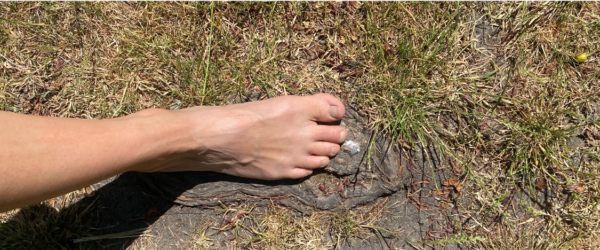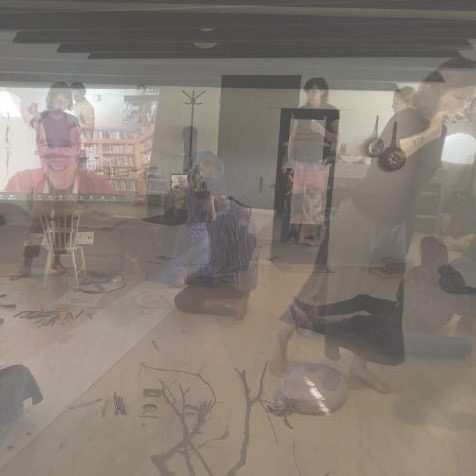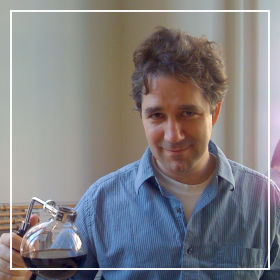Introduction: Whose Thinking?
Aja Smith and Anne Line Dalsgård
From the sounds of the third section, we turn in the fourth section to questions about whose thinking thinking really is? We begin by sharing misunderstandings, as Joseph Dumit works us through a score for playing with “the opacity of others to ourselves, and ourselves to others and ourselves” (Dumit this thread). As misunderstandings can be shared, and can be zones for thinking other thoughts, so can the haunting sound of heartbeats that come to a halt, the chasing of ghosts that do not let themselves be found, as when Robert Desjarlais grasps for the distant life of another and shows how theory always haunts both the living and death. In his characteristic poetic style, Desjarlais’ spectral theory implicitly phrases the argument that only if we dare live with and write “the fleeting traces and obscure potentialities” (Desjarlais, this thread) of those we study, may we “get it right” and “do justice” to such lives and deaths, as Mette Terp Høyby puts it in her fine review. So, dare to let go of reality as you once knew it, Ida Sofie Matzen implores in the final essay of the thread: open the soles of your feet, and allow the cool moistness of the earth, anger and affect to destabilise what you thought thinking to be, whom you thought was doing the thinking. Here again then, we meet concepts as more than simply words, they “are substantive, material, fleshy and sweaty” (Dumit, this thread); they carry in them approaches to thinking that may allow you to know and express how classic academic thinking is a “walk on eggshells”, how a more courageous thinking can at once surrender and straighten its back (Matzen, this thread).
Our concept of what we are is itself a proof; it blocks the reception of estranging perceptions.
Taken together, the essays in this section expound how concepts and theories are forces that compel and allow us to inhabit and explicate the world in particular ways; actors we have to take seriously because, willy-nilly, they form part of us as thinkers and doers. Our concept of what we are is itself a proof; it blocks the reception of estranging perceptions. We call them hauntings, but what are they, if not just unexpected responses we get from elsewhere (Merleau-Ponty 1973,134). Expectation is formed by concepts, and we must let go of them and open to this always present ‘more’ in a nonconceptual ‘quickening’ (Guyer 2013). ‘Building bodies for thought’ may thus mean not only sensitising our bodies and teaching them to be response-able, bear uncertainty, stay with hesitancy; it may also mean expanding our notion of what a body is, what a concept does and whose body that does the thinking.
In a reflection of and paying respect to the collective nature of thinking, we have chosen to cite central aspects of the reviewers comments in the relevant sections. We hope that this openness shall inspire conversations to continue beyond the thread – beyond this present thinking.
Cite this article as: Smith, Aja and Anne Line Dalsgård. June 2023. “Introduction: Whose Thinking?”. Building Bodies for Thought, edited by Aja Smith and Anne Line Dalsgård. Allegra Lab
Shared Misunderstandings
Joseph Dumit
Clearing up misunderstandings: When we (academics in universities in the US and Western Europe – where I spend perhaps too much of my time), when we interact, we often place an extreme emphasis on understanding each other, on identifying points of misunderstanding, and “clearing them up.” As if we cannot be properly sharing presence with each other if we don’t understand each other, (completely?). To say, “I don’t understand,” is to ask already for a clarification. Perhaps we are never sure, but we get closer to understanding each other, and this often relaxes us a bit, since misunderstanding can be tense.
We are opaque to ourselves. Yet we want to emphasize perspectives, identities, diversities, neurodiversities, histories, differences. If we demand translation, understandability, this can, as Edouard Glissant proposed, become an imposition of the injustice of transparency. “A person has the right to be opaque to my eyes. That doesn’t stop me from liking that person, working with him, hanging out with him, etc. A racist is someone who refuses what he doesn’t understand. I can accept what I don’t understand. Opacity is a right we must have” (2010). Glissant’s words always cause me to pause, hesitate, stumble in moving on from them.
Do you understand what I mean? These italicised words: understanding, interacting, points, sharing, clearing up, closer, relaxes, tense, pause. Are they concepts or metaphors or suggestions or impositions? Working often with improvisers (from performance studies, theatre and dance), I have come to appreciate their emphasis on improvisational games or “scores”, light sets of open-ended instructions that invite conditions for play, interaction, and insight. I became curious to bring these scores into classrooms and conferences, helping us experiment: putting into variation our too-standardized practices of talking in groups. If our ways of doing things have systematically unjust effects, what can change?
I have come to appreciate their emphasis on improvisational games or “scores”, light sets of open-ended instructions that invite conditions for play, interaction, and insight.
If concepts are or can be metaphors, and metaphors are or can be physical, then we can workshop understanding by varying with our communication rituals and habits of understanding. “Practice as research” in performance studies is a recognition that we can learn to understand differently by attentionally practicing, experimenting, with experiencing and reflecting. Use a stick to explore the ground. Without changing what you are “doing”, attend to how you are using hand+ground to explore stick, ground+stick to explore hand, ground+stick+hand to explore shoulder. Each “cut” between “self” and “not-self” is chosen, and also not entirely in control. Attention jumps.
Stick discussion score. Talk to someone for five minutes about understanding. Now share your stick with a different person and move with them+stick for five minutes without talking. Now talk with a different person for five minutes. Now stick-move with another person. In 40 minutes you have talked or moved with six people. Is this more or less comfortable than typical discussion scores where a few people speak at length and others remain silent? Here you listen deeply to another who listens to you, and you move with others while resonating with their attention. Concepts are put into shared movement.
Two-person stick-movement time can be intense. One participant shared being “unprepared and surprised for what approaching and moving would be like, every single time engaging with a new person.” Silently agreeing to move together is bodymind attunement within the held space of a workshop. Intimate because movement is shared via the stick for a long(ish) time, yet the distance of the stick and the time limit helped the process feel vulnerable yet safe. “This kind of bodily experienced vulnerability is interestingly not a closing down, a fencing off, but a crisp availability… to be moved, to understand differently than before.”

The stick-moving challenges the words just shared with the previous person. If we had just been talking about “agreement as settling into each other’s meanings,” then moving with the stick questions what “settling” and “into” mean. Each word-concept opens into physical exploration of concept-metaphors. Is slowing down together what we meant by settling, or is stopping, but for how long? If we start circling each other, is this a kind of agreement, or a kind of understanding that doesn’t settle? Maybe continuing a conversation for five minutes is an understanding that is different from the understanding that ends a conversation.
Concepts are substantive, material, fleshy and sweaty. Drawing discussion score: end with a big sheet of paper spread on floor with markers. Everyone draws-writes together for seven minutes. Then we talk about what we drew. Each change of pace, each pause, each medium, undoes our patterns and our understandings which are too pat. Repeating is iterating, timing, pace, slowness matters. Just as the way we think about anatomy changes how we move, how we move shapes how we think and discuss. An otherwise academia and world should be experimented with. Drawing then talking changes how we share, and who shares.
Unfolding moments of misunderstanding. Watching Baggs, In My Language beforehand. “I was really inspired by her sharing. I got really stuck with it. How to facilitate the process of conversation and of relating, rather than trying to jump on top with understanding conceptually… How can I relate to the paper through touch… and to the floor through the paper. So I was relating to the paper through movement…” Writing became scratching, stretching. For another, understanding became “really about relating and connecting to another person, whereas up till now I’ve been very much thinking about understanding as going on within me.”
With a little curiosity, almost any word, especially about understanding, can be a site for non-verbal physical together exploration, that disrupts (in often-delightful ways) previous understandings of that word. There is no need to know if the other is “getting it”. They are mis-understanding their own words. Sharing these misunderstandings verbally and non-verbally, serially and divergently, we learn and attune and mis-attune together. This opens yet deeper questions of the ways we use language, the multi-layered reasons why we are communicating with the persons in front of us, in this moment, at this conference, this zoom session, in this career.
Cite this article as: Dumit, Joseph. June 2023. “Shared Misunderstandings”. Building Bodies for Thought, edited by Aja Smith and Anne Line Dalsgård. Allegra Lab
No Ghost to Him
Robert Desjarlais
Preface. The words that follow stem from my participation in a workshop organised by Aja Smith and Anne Line Dalsgård, held in Denmark in 2021, geared toward embodied reflections on the concept and phenomena of understanding. The text relates to an ongoing project, in which I am trying to understand the life and death of Abdelkader Bennahar, a man from the Oran region of Algeria who died on the outskirts of Paris, France, in October 1961, during a violent clash between French police and Algerian men and women protesting French colonial rule. My writing on Bennahar’s life is based primarily on scant traces found in state archives and historical records. With each mark of tracing, grafting, I am conjuring the spectral absence-presence of someone I know only through remnant traces. The theoretical considerations that guide this approach are altogether spectral, in that I am drawing from fleeting traces and obscure potentialities in trying to grasp the distant life of another. This spectral theory – altogether faint, fragile, obscure and intangible, sensed at times with a body, through hesitant words and images – might make possible an alliance between the living and the dead, in which a relation is sustained. Then again, aren’t all theories spectral in form and haunting effect? Theories are like ghostly apparitions. They haunt the living – and the dead – in moments even of non-haunting.
____
The spectral trace of this other life is with me now, around and about my body. It’s in the words I write, images perceived, in the lands and terrains visited, archives in life and death. He is (not)there. It’s as if I have summoned a nonghost through the conjuring rites of writing and recalling. Write about a past life and revive the spirit of a life, just barely.
His name impresses on my thought within a fog of phantasmal possibilities. As I come closer to him his shade comes closer to me. It’s just a shade, shadow of what remains. There is no evident body to him, actual or virtual.
There is no ghost to him. No ghostly revenant haunting the living, as far as I can tell. There is no vital ghost for me, faint scribe of his life and death. A spectral visitant might appear for others, any surviving sons or daughters, nephews, heirs to a trace who might recall his voice in life. Or a killer who saw his face as he lay dying and the look in those dimming eyes remains still in an annihilator’s aging dreams or the dim dusk before sleep.
That is not my haunting. The haunting is another. For me he is unghosted. Any apparitions of him are vague, distant, endlessly spectral. This is not a well-formed revenant. No haunting, haunted phantomality to him. No weight or density at all to this apparition. He is scarcely there, in an altogether scarce way. Think of a ghost that never appears in a mirror, never slams a door or rattles a painting, and then take away the slight palpable sense of that ghost and you’re left with the idea of a ghostless spectre. What kind of appearance is this, if any? Can it even be called an appearance? What kind of phenomenology is required in tending to such faint, scarcely-there, scarcely perceived emergences in thought, script, or phantasmal imagining? A spectral phenomenology is called for, perhaps, one attentive to shifting apparitions in life death, cast and perceived in a spectral light (see Desjarlais and Habrih 2022).
What kind of phenomenology is required in tending to faint, scarcely-there, scarcely perceived emergences in thought, script, or phantasmal imagining?
If there is a need and necessity to live amongst spectres in postcolonial times, within a politics of haunting, memory, and justice – as Derrida has called for in Specters of Marx, “this being with specters would be also, not only but also a politics of memory, of heritage and generations,” to “live otherwise” and “more justly” – then I, like others, have been trying to learn to live with ghosts, “in the upkeep, the conversation, the company, the companionship, in the commerce without commerce of ghosts” (Derrida 1994:xvii-xviii). Yet what enigmatic commerce and companionship this is. With the being with spectres apparent here, there is not much being to the spectres. His is a ghostless spectre, hovering about the chambers of these words. Less ghost than spectre, opaque. There is something spectral in this nonappearance and nonpresence as I stumble over trace fragments. As I write of him, think on him, there is an ever-so-faint haunting trace and apparitional appearance of his post-life presence, which is not there. A few absent features, remnant qualities adhere to the spectre of him now, like the shadow of a faint trace. Just the words I write and their afterlife echoes.
Negative hauntology, trace effect, unghosted nonbeing marks the wavering appearance of something never quite there; once there, long ago; oblique, obscure, diffuse. No direct sense impression of him. No voice direct or mute. He never speaks. Silence, only. Traces of his life and death emit signs, within a vague, spectral semiology, but he himself does not sign, directly. There are no messages from the dead. No look of him toward me. Still, there is a regard, faint and spectral, if conjured only.
No sentience but the spectre of sentience.
With the spectrality of the dead there is often the sense of a remnant spirit or trace afterlife wandering about, restless, far from any fixed dwelling. Here there is a faint and remote sense of a wandering restless trace-presence of a life, and the blunt absence of such wandering.
While all along there is only his name to go by, a few post-life details, a few images. I cannot say I know him, or who he was. Nor can I correspond directly. But still, in writing about him, it feels like I am writing to him and for him. With such a distant, absent correspondence, it’s as though I am waiting to receive words or a gesture in response, which will never come.
The spectral force of him is watching, a force recalled, summoned, not present. He is observant, looking on. He demands something of me – to get the story right, get him right, more justly. I have a responsibility toward him. Care and duty toward the dead; the weight and authority of the dead.
He is (not)watching me. He is watched by me. I do not speak to him, directly. I write about him. Revive the conjured spectre of him.
If anything, I am haunted by the non-haunting.
How might one relate to a dead man? Can we align ourselves too closely with traces of a past life? Can such an affinity bring a life closer to sheer absence?
He is scarcely not there.
Cite this article as: Desjarlais, Robert. June 2023. “No Ghost to Him”. Building Bodies for Thought, edited by Aja Smith and Anne Line Dalsgård. Allegra Lab
Bare Feet Anger
Ida Sofie Matzen
Is anger a good point of departure for approaching theory? To consider this question, I string together a barefoot walk, a divorce, awareness of body sensations and Glissant’s (2010) notion of opacity – all to consider the seeming soundness and lucidity of rational knowledge as opposed to more immediate somatic sensations. In outrage or other shock-like conditions, we – at least momentarily – lose grip of what we thought reality was; a destabilisation that potentially allows for the not-yet-manifest.
During early summer 2021, a group of anthropologists with different praxis-approaches to bodily knowledge were gathered for a workshop dedicated to exploring what understanding might mean if we sidestep our usual favouring of intellectual knowledge.

Besides being anthropologists, people worked with dance, voice-work, hypno- and body therapy, creative writing and the like. One exercise got us together in groups of three; one blindfolded, guided by the other two. When my turn, I was not only blindfolded but also chose to be barefoot, inviting in a whole battery of impressions: an acute intensity while opening up the soles of my feet to leaves, earth and ants, smell of horse and human, the density of bodies and a surge of gratitude to the kind folks leading me so attentively.
Later we were invited to write texts with a one-hundred-word constraint guided by anthropologist Kathleen Stewart. One of mine turned out like this:
‘Why’ is like a wide-open closure, either soliciting an answer that stands, definite and disappointing, or calling forth a silence, a non-responsive assertion able only to leak into thin air. The mind’s constant readiness to find patterns in any kind of glimpse, landmark or encounter, in pebbles thrown on the concrete in front of the mall, in the bundle-like feathers of a decaying swallow on the barn floor, in the sentences dropped in space, here, by two people passing by. Could we only stop editing the world and worlds within us, allowing them the right to be opaque, hesitating, tender?
I guess my attempt was to express an intangible longing for a more mind-free letting be, as it is, not retreating too quickly, if at all, into what I think about experience and other such layers of definitory settlements. To listen compositionally, non-interfering, pausing – for a second letting go and giving in to modes that are not fettered by or limited to this smaller unit called me. Could this be a viable way of arriving within more open-ended and collective (though not universal) forms of thinking and knowing? Because if rational knowledge is what we can obtain through reason and cognitive assessments of the phenomena of reality brought into us through our senses, then what to do with all the “extra” – the sensorial, primordial-like and spontaneous displays and ephemeral stuff that also characterises lived life, including academic practices? Isn’t the mind clean openness from the outset, that is, before we begin to pin down reality? I long for (conceptual) elsewheres and elseworkings, closer to the present.
This is where I arrive at anger. It feels as if I wrote the above 100s from some kind of future-memory stored in my somatic-sensory system. Amidst a divorce and a prolonged break-up with academia, my body gives into a long rejected yet persistent rage against any kind of assertiveness based on proposed rational knowledge. “You’re too sensitive”, such reasoning says, as it fixates and separates stuff from itself in its pursuit of self-preservation. My anger knows that pure rational reasoning (lifted up as the great ideal we should all try to achieve) is self-righteous, judgemental, almost narcissistic in its unwillingness to accept other kinds of perceptive faculties than its own mind-based logics. Jungian therapist and feminist thinker Sylvia Perera writes about “the defensive fear inherent in hierarchical, [progress-oriented], heroic consciousness that turns from the flow of change and its own split-off ““infantile” impulses’” (1981: 30). Raging like a four-year-old, I realise how sick I am of walking on eggshells of contrived explanations to the countless whys of existence.
My anger is vibrating vigorously, brisk and draining, both personal and more archetypical in the sense that it is targeted towards the linear, the masculine, not gender-wise, but in both men and women, in us. Anger has the potential to straighten the back; it offers a candid quality to boundary-settings and fuels determination. One can go into war on anger; we do go into war on anger.
To face dissonance is indeed unsettling, but I suggest that to surrender into the psychic-somatic level of the basic hurt, a semi-controlled regression into what also is, may lead to a radical reorganisation of the world.
Perhaps my anger is spurring me into the same manoeuvre I am so critical of; in my longing to connect with a world beyond – and still intimate with – my own being, haven’t I maintained to separate hierarchical logos modes from the infinite sensorial, dense and messy (somatic) realms? I stamp my bare feet even harder at the eggshells. I don’t want to fight against my rage any longer. My alarmed instincts squirm as I resolve to give up. The nervous system shudders, anger and anxiety are kindred spirits; the potency of fury is too overwhelming. And beneath? Sheer fright, loneliness, sorrow – an infinite abyss, it seems. Giving into anger, allowing it to toil within me and not (for at least a moment) projecting it out or acting from it, I let go of reality as I know it. To face dissonance is indeed unsettling, but I suggest that to surrender into the psychic-somatic level of the basic hurt, a semi-controlled regression into what also is, may lead to a radical reorganisation of the world – and hence how we understand it.
With anger as a somatic entry point into such radical state of immediate unreality, there are no handles, not a container to hold together normal concepts, to make them coherent – and out of trouble. Staying (somatically) with the trouble (cf. Haraway 2016) is raw, not pretty or pleasant, but a claim to the right to opacity. Recognising difference, to paraphrase Glissant (2010), does not mean understanding otherness by making it transparent through, say, linear argumentation, persuasive expositions and other forms of violence (against bodies, nature, Earth, against others and selves). How to accept the unintelligibility and confusion that often characterise cross-cultural (and inter- and intrapersonal or even interspecies) communication? To be right – or to be in relation? How to straighten the back and surrender into the chaotic order of the body, not an imposed order, but an allowing one (Perera 1981: 26). And possibly giving in into a more compassionate perspective not conditioned by pursuits of stabilising?
Padmasambhava, an 8th century Buddhist master, said on the difference between perspective and conduct: “Though the view should be as vast as the sky, keep your conduct as fine as barley flour”. According to Tibetan teacher Urgyen Tulku (2000: 81), this means to not confuse an open mind with an accepting and noncommittal conduct: “you can be as unbiased, as impartial, as vast, immense, and unlimited as the sky (…) But one’s behaviour should be as careful as possible in discriminating what is beneficial or harmful – as fine as barley flour” (ibid.). In one’s behaviour, it is necessary to accept and reject. If anger can mobilise action, manifest a mandate to build up or tear down, how to still be available with a view, a perspective (more) wide-open, not defining, not defiling the relational between, among and within us? How to build concepts that are relational before righteous, opaque above coherent and yet as fine as barley flour?
With as much consciousness as we can muster, dialoguing with the more immediate, overwhelming and hazy sides as well as with the clearer and more logical ones, any (personal and conceptual) crises may open up new parts of ourselves and the worlds while being neither right nor wrong. With bare feet and with anger, I straighten and stumble, my mind vaster.
Cite this article as: Matzen, Ida Sofie. June 2023. “Bare Feet Anger”. Building Bodies for Thought, edited by Aja Smith and Anne Line Dalsgård. Allegra Lab
References
Baggs, Amanda. 2008. In my language. At YouTube.
Derrida, Jacques. 1994. Specters of Marx, the State of the Debt, the Work of Mourning, and the New International. New York: Routledge.
Desjarlais, Robert and Khalil Habrih. 2022. Traces of Violence: Writings on the Disaster in Paris, France. Berkeley: University of California Press.
Glissant, Édouard. 2010. Poetics of Relation. University of Michigan Press.
Guyer, Jane. 2013. “‘The quickening of the unknown’: Epistemologies of surprise in anthropology” (The Munro Lecture, 2013). HAU 3(3): 283–307.
Haraway, Donna. 2016. Staying with the Trouble. Making Kin in the Chthulucene. Duke University Press. Durham and London.
Merleau-Ponty, Maurice. 1973. The Prose of the World. Evanston: Northwestern University Press
Perera, Sylvia Brinton. 1981. Descent to Goddess. A Way of Initiation for Women. Inner City Books. Toronto.
Urgyen Rinpoche, Tulku. 2000. As It Is, Volume II. Rangjung Yeshe Publications. Hong Kong.









